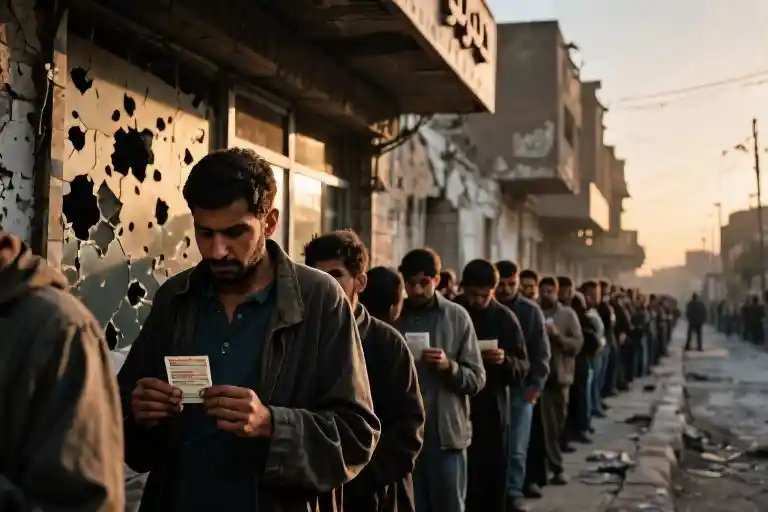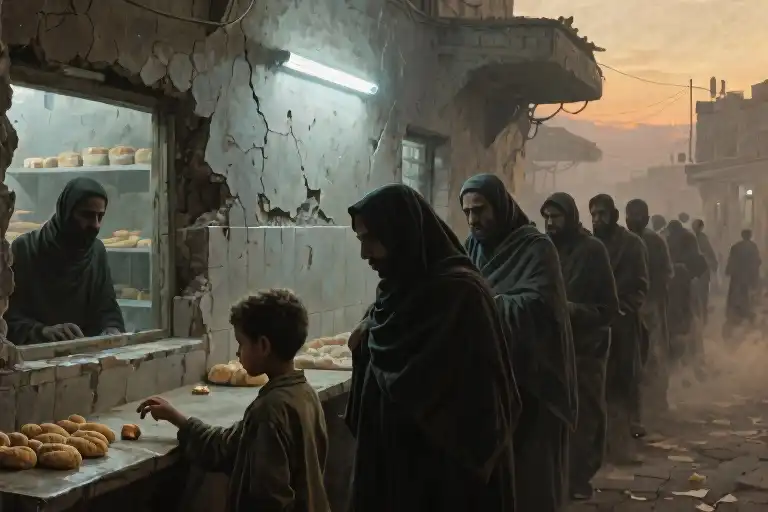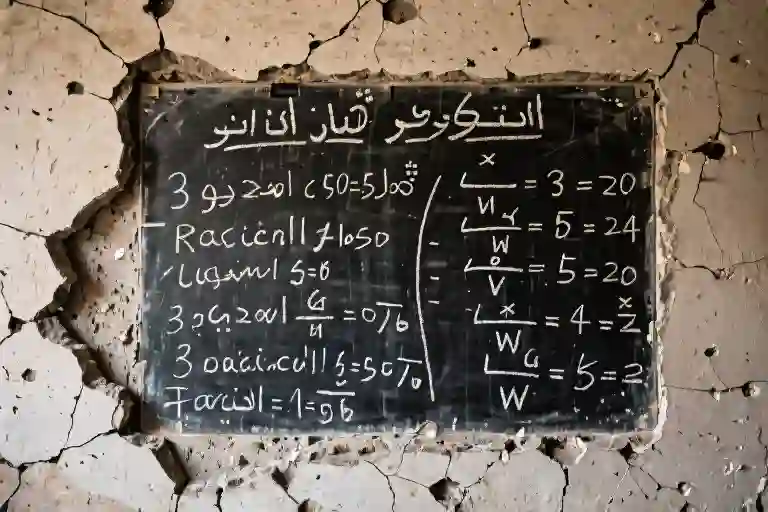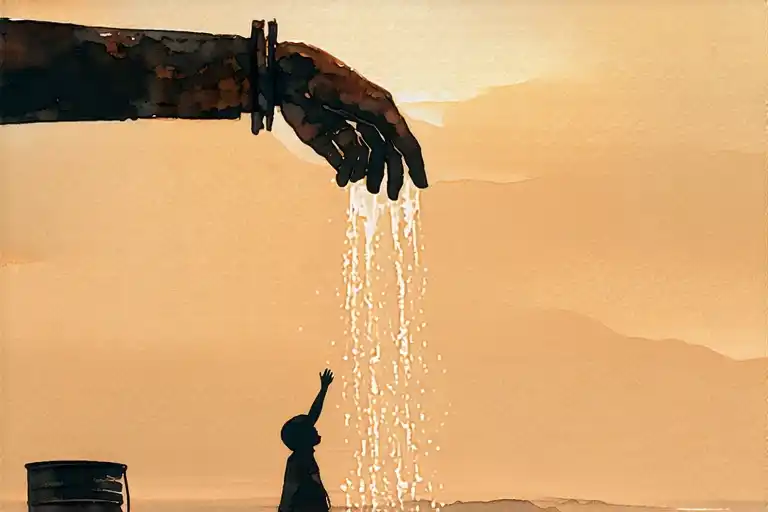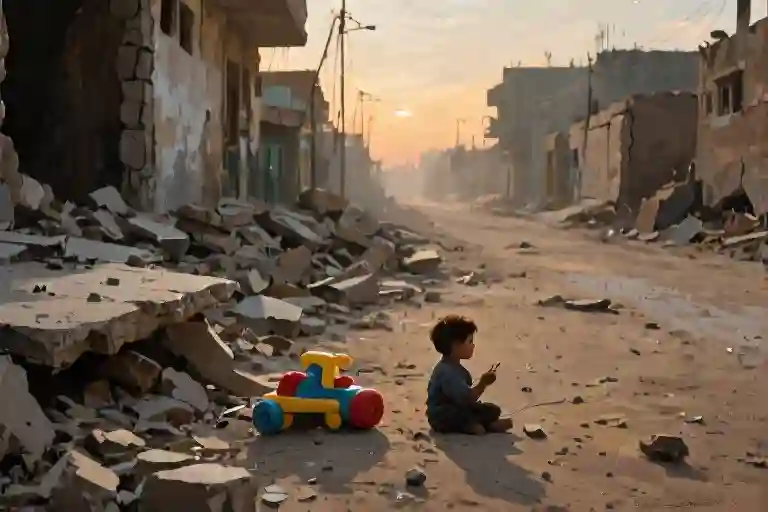The first light hasn’t yet touched the rubble-strewn streets when Noor knots her grandmother’s ID around her neck with a piece of torn cloth. This flimsy cord holds more than just plastic – it’s a lifeline, a temporary pass into the brutal hierarchy of Gaza’s breadlines. By 4:17 AM, the queue outside Al-A’elat Bakery already stretches three blocks, a human chain of hollow cheeks and twitching eyelids where people sway on their feet like wheat stalks in wind.
White bread here carries the metallic taste of risk assessment. What international food security reports dryly call ‘caloric intake’ translates to desperate calculus: Is today’s flour shipment worth the three-hour exposure to potential airstrikes? Will the elderly woman two spots ahead collapse before reaching the counter, creating one precious vacancy? These are the equations of survival in Gaza’s bread crisis, where every loaf represents a gamble measured in footsteps and fear.
Near the bakery’s bullet-pocked entrance, a teenage boy presses his forehead against the wall, reciting numbers under his breath. He’s memorizing his place in the invisible queue-within-a-queue – the one that forms when bakery employees discreetly distribute numbered scraps to those who bribe with cigarettes or antibiotics. This shadow system emerged three months after the war intensified, when standard lines became too dangerous for anyone without children or white hair to wave as human shields.
The smell hits first – that cruel mockery of normalcy – as the steel shutters roll up at 6:00 AM sharp. Warm yeast and scorched flour drift over the crowd, triggering stomach growls that sound oddly like suppressed sobs. For regulars, this scent carries memories of simpler mornings when bread meant breakfast, not blood price. Now it’s an olfactory trigger for trauma; many cover their noses when the aroma grows stronger, having learned to associate it with the minutes before last month’s bakery bombing in Rafah.
Noor’s fingers worry the edges of her grandmother’s ID photo. The laminated smile from 2005 shows a woman who could still access bakeries without fearing collapse. That version of Gaza seems as distant as the moon today, where even UN-branded flour sacks arrive stamped with expiration dates from pre-war stockpiles. As the line lurches forward, she notices the boy ahead cradling something in his cupped hands – not bread, but a smartphone displaying a live map of recent strikes. They’re all playing this macabre game now: calculating whether the bakery’s location falls outside the day’s bombardment radius.
By mid-morning, the crowd’s collective exhaustion takes on physical form. Shoulders slump like deflated balloons, feet shuffle through layers of discarded number tags, and the once-sharp division between queues dissolves into a single mass of trembling humanity. This is when the fights break out – not over politics or ideology, but centimeters of pavement space. A woman near Noor suddenly screams when someone steps on the plastic bag she’s saved for carrying bread; another man accuses his neighbor of cutting in line by ‘only’ having one child instead of three. The bakery workers watch through the bars of their service window, doling out loaves with the grim efficiency of prison guards serving last meals.
What no emergency briefing captures is the soundscape of these lines – the wet coughs of malnutrition, the rustle of UN ration cards being checked and rechecked, the arrhythmic tapping of fingers counting remaining coins. Occasionally, a sharp cry slices through when someone receives news of another bakery hit. The information spreads through the queue like a reverse wave, each person recalculating their survival odds based on one less option for tomorrow.
As Noor finally nears the counter, she catches fragments of the baker’s conversation with the customer ahead: ‘…only half-rations today…flour convoy turned back at checkpoint…’ The man behind her begins weeping silently, his tears cutting clean streaks through the dust on his face. She tightens the knot around her neck, grandmother’s ID digging into her skin like a reminder – this is what passes for privilege now, this fragile hierarchy of desperation where even the right to risk your life must be earned.
The Price of Bread in Gaza
At 4:17 AM, the line outside Al-A’elat Bakery already stretches three blocks. Women wrap thin shawls tighter around their shoulders as the coastal wind carries the scent of yeast and desperation. In Gaza today, white bread isn’t just breakfast—it’s currency, it’s status, it’s survival. The UN estimates each loaf now represents 6 hours of a family’s daily caloric intake, when they can get one.
The Queue as Battlefield
What looks like disorder follows brutal rules. Elderly women cluster near bakery doors, their presence a tactical advantage—bakers often prioritize the visibly fragile. Teenagers trade places for a handful of shekels, while mothers balance infants on their hips like human shields against the jostling crowd. Last Tuesday, a fistfight broke out over position #203 when someone spotted a baker carrying only 180 loaves.
Supply chain collapse has turned every transaction into life-or-death calculus. Before the war, Gaza had 128 bakeries receiving daily flour shipments. Now, satellite imagery shows just 17 operational facilities, all dependent on erratic UN convoys. The math is cruel: 2.3 million people, 34 ovens, 1 airstrike every 6 hours near food distribution points.
The Economics of Hunger
At the Khan Younis market, wartime pricing tells its own story:
- 2019: 1 kg flour = 0.50 USD
- 2023: 1 kg flour = 3.20 USD
- 2025: 1 kg flour = 18.75 USD (when available)
Bakers have started mixing sawdust with wheat—not to cut costs, but to stretch each sack into 50 more loaves. ‘We call it war bread,’ says Mahmoud, whose family once ran Gaza’s largest bakery. ‘The sawdust stops children’s stomachs from cramping with hunger pains.’
The true currency isn’t money anymore. At checkpoint barricades, people trade:
- 1 antibiotic pill = 3 bread rations
- 1 liter fuel = 1 week’s bakery queue priority
- 1 UN food voucher = 2 hours safe passage
The Shifting Frontlines
Bakery locations become strategic targets in unexpected ways. Last month’s bombing of the Firas Flour Mill didn’t just destroy machinery—it erased the knowledge of workers who’d kept 1940s-era equipment running. Now, surviving bakers whisper about ‘ghost bakeries,’ makeshift ovens hidden in bombed-out buildings where a single lightbulb’s glow could mean death.
What statistics can’t capture are the sensory details of this crisis:
- The way flour dust hangs in the air after airstrikes, like snow over rubble
- How mothers teach children to distinguish distant explosions from nearby ones by the bread’s vibration in the oven
- The metallic taste that replaces wheat flavor when bakeries recycle shrapnel-contaminated sacks
This isn’t just food scarcity—it’s the systematic unmaking of daily life. As one father told me while weighing whether to send his daughter to queue: ‘When getting bread feels like gambling, you start wondering what exactly you’re betting with.’
The Calculus of Survival: Trading Antibiotics for Bread
The decision happens in the quiet moments before dawn, when the hum of drones blends with stomachs growling. Fathers in Gaza don’t choose between good and bad options—they weigh certain hunger against probable death. My father’s fingers would tap our sole remaining antibiotic packet like a metronome, measuring time against infection risk. “One pill buys two loaves at the market near Shati,” he’d murmur, as if bargaining with himself.
This is Gaza’s new arithmetic:
- 1 course of amoxicillin = 3 days of bread for a family of five
- 1 insulin vial = 5 kilos of UN flour (when shipments arrive)
- 1 hour waiting at a bakery = 17% chance of encountering an airstrike (UNOCHA data, March 2025)
The underground exchange networks operate with terrifying precision. At the destroyed Al-Wehda Street market, I watched a pharmacist examine antibiotics under a child’s flashlight. “Expired but still tradable,” he declared, handing over wrinkled bread coupons printed on recycled cement bags. These coupons circulate like blood through Gaza’s collapsing veins—some bakeries honor them, others demand “supplemental fees” in cigarettes or candles.
What they don’t tell you about war economies:
- Medication becomes currency before cash does. My sister’s asthma inhalers disappeared first, traded for yeast when the black market price spiked.
- Priority systems invert. The elderly get pushed to the front of bread lines not from kindness, but because their higher mortality makes them expendable couriers.
- Every transaction carries betrayal. That neighbor offering to share flour? Probably hoarding UN ration cards to sell later.
We developed survival tells—a twitch when hearing distant explosions meant someone had calculated the risk radius. My father’s tells were subtler: the way he’d fold a bread coupon into smaller and smaller squares while deciding whether to risk the journey. The morning we heard about Al-A’elat Bakery’s destruction, he unfolded one such square and burned it slowly over our stove. The ashes smelled like stolen wheat and resignation.
Gaza’s children now play “bakery queue” instead of hopscotch. They argue over who gets to pretend being the shopkeeper distributing imaginary loaves. The rules keep changing—sometimes airstrikes cancel all turns, sometimes soldiers take half the bread. Nobody wins. The game just ends when someone starts crying.
The Last 24 Hours at Al-A’elat Bakery
By noon, the bakery’s metal shutters had begun to warp from the heat of too many bodies pressed together. The air smelled of yeast and desperation – that particular Gaza blend where hunger sharpens every sense. I remember counting 73 people ahead of us in the women’s queue, each clutching ration cards like winning lottery tickets. My youngest sister kept tugging my sleeve: “Do you think they’ll still have the bread with sesame seeds?”
Near the ovens, a fight erupted over loaf #47. A man in a torn Manchester United jersey had grabbed two loaves instead of his allotted one. Within seconds, three women were on him, their nails drawing blood. Someone’s teeth sank into his wrist until he dropped the extra bread. The bakery owner shouted over the chaos: “We’re all hungry! But we’re not animals!” The irony hung thicker than the flour dust.
Military analysts later called it “infrastructure degradation” – the systematic destruction of bakeries, water plants, and pharmacies. What they don’t say is how these places become living archives first. That morning, Al-A’elat’s walls held:
- Finger-smudged lists of families owed bread on credit
- A child’s drawing of a smiling loaf taped near the cash register
- The imprint of a hundred foreheads pressed against the counter in exhausted prayer
We left when the electricity cut out again, the ovens going cold mid-batch. The owner promised to save us three loaves if we came back after sunset. My father hesitated at the door, watching a teenage boy lick flour off the floor. That image – more than the later news reports – made me understand why they bomb bakeries. Not just to destroy food, but to erase the last places where people still believe in sharing.
The strike came at 3:17 PM. Survivors described the sound first – not the explosion itself, but the momentary silence as the building inhaled. Then the ovens erupting like volcanoes, scattering half-baked loaves across the street like shrapnel. Rescue teams found 22 bodies in the flour silo, their hands still clutching empty sacks. The military spokesperson called it “an unfortunate miscalculation of militant activity.”
What they never explain is the timing. Not during the midnight flour deliveries when workers might be targets. Not at dawn when queues form. But mid-afternoon, when Gaza’s grandmothers knead dough for dinner, when children stop by after school hoping for burnt crusts. There’s a particular cruelty in destroying bread at the hour when hunger sharpens its scent.
Now when I walk past the rubble, I don’t see a destroyed building. I see the ghost of that last batch – 200 loaves that would’ve been done by 3:30, their steam rising through bullet holes in the ceiling. I hear the owner’s voice counting down from his daily mantra: “Flour, water, salt, hope.” Always in that order.
The Silent Bystanders: Why International Aid Fails Gaza
It happens every Tuesday at the Kerem Shalom crossing. UN trucks loaded with flour sacks idle for hours under the desert sun, their drivers chain-smoking as paperwork gets scrutinized line by line. Last month, a convoy carrying 30 tons of wheat – enough for 100,000 loaves – waited 14 hours before being turned back for ‘incomplete manifests’. The flour spoiled in the heat.
This is the grueling reality of Gaza’s aid delivery system. While global donors pledge millions, the actual mechanics of getting food past checkpoints resemble a cruel obstacle course. A 2025 UN report revealed that 63% of approved food aid never reaches intended recipients, diverted due to:
- Logistical chokeholds: Single-entry crossings operating at 20% capacity
- Bureaucratic delays: Average 72-hour clearance process for perishables
- Security theater: Random truck dismantling that damages supplies
Yet the most devastating failures happen after supplies finally enter Gaza. The bombing of the UNRWA warehouse in Deir al-Balah last March wasn’t just a tragedy – it exposed the systemic vulnerability of centralized aid distribution. When that facility was hit, 15,000 families lost their monthly ration cards in the fire.
What You Can Do Right Now
Waiting for governments to fix broken systems is a luxury Gaza doesn’t have. Here are three concrete ways to bypass the red tape:
- Direct-to-family donations: Organizations like Gaza Kitchen Collective work with local bakers to distribute bread coupons to high-risk households (verified via blockchain records)
- Pressure points: The #CheckTheManifests campaign tracks stalled aid shipments in real-time, providing evidence for legal challenges
- Alternative routes: Some groups now ship flour via maritime corridors – supporting these efforts costs less than your weekly coffee budget
The bitter irony? Many of these solutions were invented by Gazans themselves. When international systems fail, civil society stitches together stopgaps – like the underground bakeries using donated solar panels to avoid fuel shortages. Their resilience deserves more than our pity; it demands our participation.
As I write this, another 50 trucks sit at Rafah crossing. The flour inside could make 200,000 loaves. But right now, in some Gaza basement, a mother is grinding birdseed into something vaguely resembling dough. The gap between those two realities is where real change must happen.
The Taste of Ashes and Dough
At 3:17 PM, the scent of freshly baked bread still lingered in the air when the ground shook. Later, survivors would describe the moment in fragments – how the yeasty warmth from the ovens mixed with the metallic tang of blood, how flour dust suspended in sunlight became funeral shroud. The coordinates of Al-A’elat Bakery ceased to exist that afternoon, joining seventeen other bakeries erased from Gaza’s map since January.
We’d left empty-handed hours earlier, my father’s callused palms pressing my shoulders as he steered us through the shouting crowd. His decision to abandon the queue felt like failure then. By dusk, it became our family’s second miracle that week – the first being finding yeast at the market. Survival here follows cruel arithmetic: every avoided catastrophe gets weighed against invisible threats still circling overhead.
International reports will list the bakery’s destruction as ‘collateral damage’, a sterile phrase that dissolves thirty-seven names into statistics. For those who queued daily, the crater represents something more intimate – the loss of Gaza’s last remaining oven capable of producing taboon bread, that golden disc with charred bubbles we’d tear apart on happier mornings. Now flour sacks gather dust in UN warehouses while mothers bake ‘war bread’ from animal feed, their fingers kneading desperation into every lumpy loaf.
Three weeks after the bombing, my sister spotted a Facebook post: someone selling smuggled Turkish flour near what remained of the bakery. The price equaled a nurse’s monthly salary. My father spent that evening staring at our dwindling savings, calculating whether flour or antibiotics held better odds of keeping us alive till summer. This is what ‘recovery’ looks like here – not rebuilding, just grim triage between impossible choices.
Support Gaza’s remaining bakeries through UNRWA’s emergency food program. Your donation could buy twelve hours of oven fuel – enough to bake 400 loaves without bloodshed.

